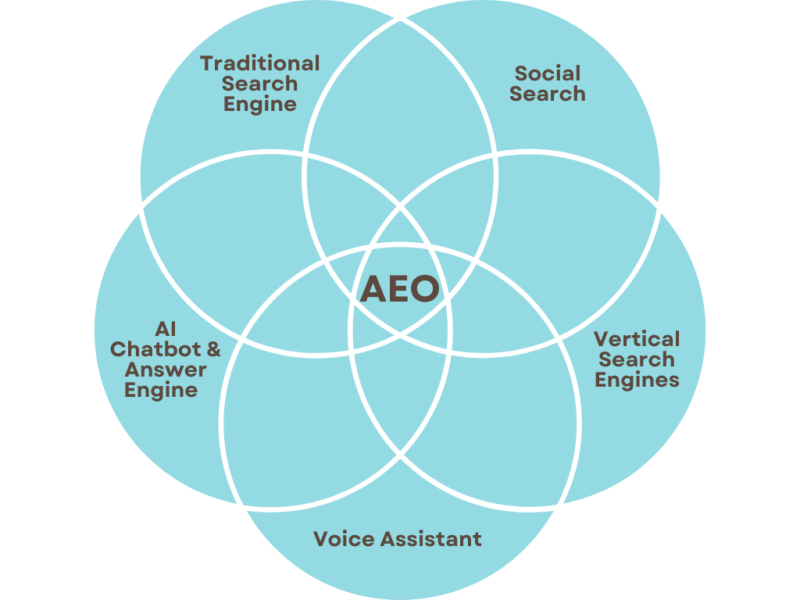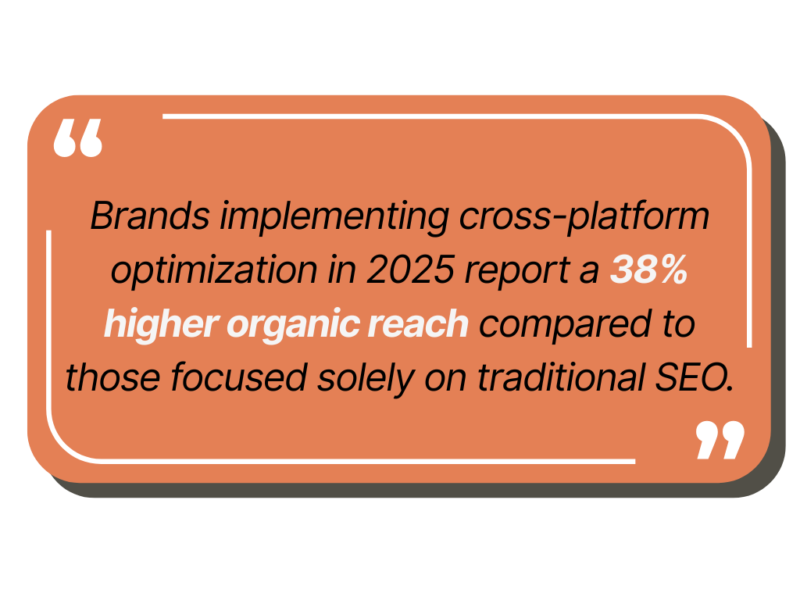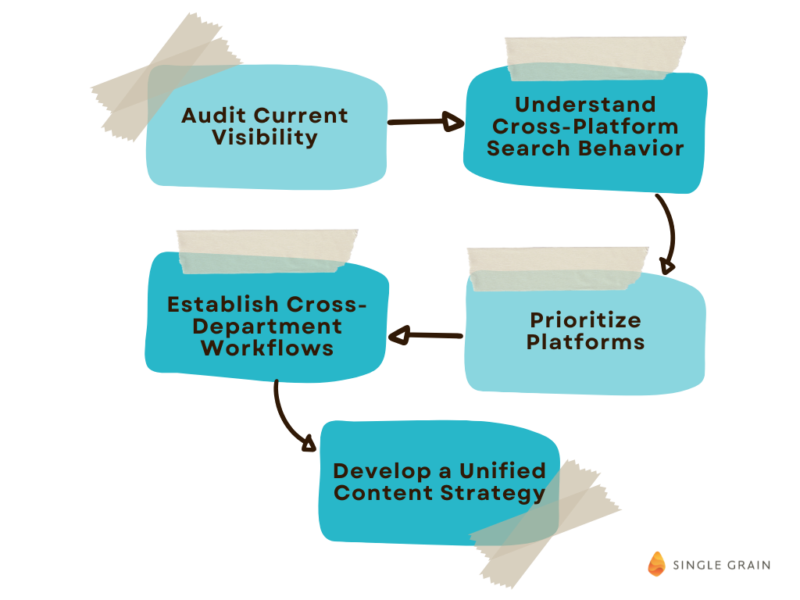How to Do Answer Everywhere Optimization: A Multi-Platform Visibility Strategy for 2025
The days of focusing solely on Google rankings are long gone. Today’s digital landscape demands a more comprehensive approach to visibility. According to Neil Patel, brands are optimizing for at least 5 major channels, including traditional search engines, social networks, AI chatbots, shopping platforms, and emerging mediums like podcasts. This fragmentation of search behavior has given rise to answer everywhere optimization – a strategy that ensures your content is discoverable no matter where your audience is looking.
For marketing professionals facing this new reality, the challenge isn’t just about ranking well on Google anymore; it’s now focused on maintaining consistent visibility across an expanding ecosystem of search interfaces.
Key Takeaways
- Implement entity mapping and structured data to ensure consistent brand recognition across platforms by identifying core entities, using schema.org markup, and creating entity-centric content that machines can understand.
- Develop platform-specific optimization strategies for different search interfaces, including AI chatbots (focus on natural language questions), social media (platform-specific formats), and traditional search engines to maximize visibility.
- Create repurposable content by developing comprehensive core assets that can be efficiently transformed into platform-specific formats while maintaining consistent messaging across all channels.
- Establish cross-department workflows between SEO specialists, social media managers, content creators, and developers to ensure coordinated answer everywhere optimization efforts across your organization.
- Measure success beyond traditional SEO metrics by tracking cross-platform visibility scores, answer rate analysis, entity association strength, and implementing multi-touch attribution models that capture the full customer journey.
TABLE OF CONTENTS:
What is Answer Everywhere Optimization?
Answer everywhere optimization is a holistic approach to ensuring your brand’s content is discoverable and properly positioned across the entire digital ecosystem. It acknowledges that modern consumers use multiple platforms to find information relevant to their needs and questions.
According to Lounge Lizard, 72% of consumers in 2025 regularly use at least three different platforms (search engines, social media, and AI chatbots) to find information. This diverse search behavior means that focusing solely on traditional SEO is now insufficient.

Answer everywhere optimization integrates several distinct but interconnected disciplines:
- Traditional search engine optimization (Google, Bing)
- Social search optimization (TikTok, Instagram, YouTube)
- AI chatbot and answer engine optimization (ChatGPT, Claude, Bard)
- Vertical search engines (Amazon, Spotify, App Stores)
- Voice assistant optimization (Alexa, Siri, Google Assistant)
Why Answer Everywhere Optimization Matters
Implementing answer everywhere optimization offers substantial business impacts. According to Single Grain, brands implementing cross-platform optimization in 2025 report a 38% higher organic reach compared to those focused solely on traditional SEO.

More impressively, marketers who optimized content for at least five platforms saw a 44% increase in conversion rates, demonstrating that meeting your audience where they are searching doesn’t just drive traffic—it drives meaningful business results.
This approach addresses several key challenges facing marketing teams today:
- Fragmented audience attention: Your audience isn’t concentrated on a single platform anymore
- Reduced traffic from traditional search: AI systems now answer queries directly without sending users to websites
- Platform-specific discovery behaviors: Users search differently on TikTok than they do on Google or Amazon
- Content discovery shifting away from keywords: Entities and relationships matter more than exact keyword matches
Creating Your Answer Everywhere Optimization Strategy

Implementing effective answer everywhere optimization requires a systematic approach. Here’s how to develop a comprehensive strategy:
Step 1: Audit Current Visibility
Begin by assessing your current presence across different platforms:
- Map your visibility across all major search interfaces
- Identify platforms where your presence is strong vs. weak
- Analyze competitor visibility for benchmark comparison
- Use tools like SEMrush, BrightEdge, or Conductor that now offer cross-platform visibility metrics
Step 2: Understand Cross-Platform Search Behavior
Document how your specific audience searches across different platforms:
- What types of questions do they ask on Google vs. ChatGPT?
- What product information do they seek on social media vs. search engines?
- How do query formats differ across platforms (keywords vs. natural questions)?
- Which platforms are used at different stages of the customer journey?
Step 3: Prioritize Platforms
While comprehensive coverage is ideal, most organizations need to prioritize:
- Identify where your audience spends the most time searching
- Determine which platforms drive the most valuable traffic
- Consider your organization’s content creation capabilities
- Start with 3-5 key platforms before expanding further
Step 4: Establish Cross-Department Workflows
Answer everywhere optimization requires input from multiple teams:
- SEO specialists for search engine optimization
- Social media managers for platform-specific knowledge
- Content creators for adaptable, high-quality content
- Developers for technical implementation of structured data
- Analytics teams for cross-platform measurement
Create clear workflows that facilitate collaboration between these teams to ensure consistent messaging across platforms.
Step 5: Develop a Unified Content Strategy
Plan content that can be effectively repurposed across platforms:
- Create comprehensive “pillar” content as your foundation
- Design with repurposing in mind from the start
- Maintain consistent core messages while adapting formats
- Build content calendars that coordinate cross-platform publishing
Key Components of Answer Everywhere Optimization
To successfully implement answer everywhere optimization, focus on these core components:
Entity Mapping and Knowledge Graph Integration
Modern search and discovery systems rely heavily on entity recognition—understanding the “things” your content discusses rather than just the keywords.
- Identify Core Entities: List all entities related to your brand: products, services, people, locations, concepts, and how they relate.
- Implement Structured Data Markup: For machine understanding, use schema.org markup to explicitly define entities and their relationships.
- Claim Knowledge Panel Entries: Verify your presence on platforms like Google Business Profile, Wikidata, and relevant industry databases.
- Create Entity-Centric Content: Structure content around defined entities rather than just keywords.
This approach forms the foundation of your answer everywhere optimization strategy by ensuring consistent entity recognition across platforms.
Platform-Specific Optimization Frameworks
Each platform has unique ranking factors and content preferences:
AI Chatbot and Answer Engine Optimization
AI systems like ChatGPT, Claude, and Google’s SGE require specific approaches:
- Conversational Keyword Research: Focus on natural language questions rather than traditional keywords
- Atomic Content Design: Structure information in self-contained, easily extractable modules
- Citation Optimization: Include clear statistics, definitive statements, and proper attribution
- E-E-A-T Enhancement: Strengthen Experience, Expertise, Authoritativeness, and Trustworthiness signals
Social Search Optimization
Social platforms have become significant search destinations with unique requirements:
| Platform | Optimization Tactics |
|---|---|
| TikTok | – Front-load keywords in first 3 seconds – Use text overlays that match search phrases – Answer specific questions in under 60 seconds |
| – Optimize captions with searchable terms – Use descriptive alt text for images – Create carousel posts for sequential information |
|
| YouTube | – Optimize video chapters as FAQ sections – Create detailed descriptions with timestamps – Use keyword-rich closed captions |
Case Study: NerdWallet
Challenge: NerdWallet faced a 20% decline in monthly website traffic as users shifted from traditional search to AI chatbots and answer engines.
Solution: They adopted an answer engine optimization strategy by developing content optimized for AI-powered engines and chatbots, ensuring presence across platforms like ChatGPT, Bing AI, and social media answer surfaces.
Results: Despite the drop in organic traffic, NerdWallet experienced over a 35% revenue growth in 2024.
Key Takeaway: Optimizing for AI and cross-platform answer engines can turn declining traditional traffic into significant revenue growth by meeting customers where they’re actually searching.
Content Repurposing for Multi-Platform Visibility

Rather than creating unique content for every platform, smart repurposing maximizes efficiency while maintaining platform relevance. According to Lounge Lizard, 84% of leading brands now repurpose content across multiple platforms as part of their cross-platform strategy.
Effective content repurposing follows this process:
- Create Core Content Assets: Develop comprehensive, research-backed pieces that contain all key information about a topic.
- Break Down into Platform-Specific Formats: Transform the core content into formats optimized for each platform:
- Long-form articles for search engines
- Short visual explainers for Instagram
- Quick demonstration videos for TikTok
- Conversational Q&A for AI chatbots
- Step-by-step tutorials for YouTube
- Maintain Message Consistency: While format changes, ensure core information and brand messaging remains consistent.
- Cross-Link When Possible: Where platforms allow, link between different versions of your content.
Cross-Platform Content Synchronization
To maintain consistency while allowing for platform-specific optimization, implement a hub-and-spoke content model:
- Create Pillar Content: Develop comprehensive resources on core topics that serve as the “hub” for your content ecosystem
- Develop Platform-Specific “Spokes”: Create platform-optimized versions that link back to the main pillar content
- Maintain a Central Content Calendar: Coordinate publishing across platforms to amplify reach
- Implement Cross-Team Workflows: Ensure all teams collaborate on unified messaging
Measuring Success in Answer Everywhere Optimization
Traditional SEO metrics don’t capture the full impact of answer everywhere optimization. Implement these measurement approaches:
- Cross-Platform Visibility Score: Create a weighted average of visibility across your priority platforms
- Answer Rate Analysis: Track the percentage of relevant queries where your content appears in featured snippets, AI-generated answers, and social search results
- Entity Association Strength: Analyze how strongly your brand is associated with key topics across platforms
- Multi-Touch Attribution: Implement attribution models that capture the customer journey across diverse platforms
- Engagement Analysis by Platform: Compare how similar content performs across different platforms
You can leverage tools like conversion rate optimization tools to help measure the effectiveness of your answer everywhere optimization efforts.
Common Challenges and Solutions
Organizations often face these obstacles when implementing answer everywhere optimization:
| Challenge | Solution |
|---|---|
| Resource Constraints | Prioritize platforms based on audience research; start with core content that can be efficiently repurposed |
| Siloed Teams | Create cross-functional workflows and shared KPIs that encourage collaboration between SEO, social, and content teams |
| Rapidly Changing Algorithms | Focus on evergreen content principles that tend to perform well regardless of algorithm changes |
| Measuring Cross-Platform Impact | Implement unified analytics dashboards that capture touchpoints across platforms |
The Future of Answer Everywhere Optimization
As you build your answer everywhere optimization strategy, keep these emerging trends in mind:
- AI-Generated Content Evaluation: AI systems will get better at evaluating content authenticity and value
- Voice and Visual Search Integration: Multi-modal search will require optimization for spoken queries and visual elements
- Personalization at Scale: Platforms will increasingly serve different content to different users based on behavior
- Multimodal Optimization: Content combining text, images, audio, and video will gain advantage
- First-Party Data Activation: Leveraging your audience data for cross-platform optimization becomes critical as third-party cookies disappear
For brands looking to stay ahead of these trends and implement search everywhere optimization strategies effectively, partnering with specialists can accelerate results. Ready to take your multi-platform visibility to the next level? Work with the leading AEO agency to develop a comprehensive strategy tailored to your business goals.
Combatting an Increasingly Complex Digital System
Answer everywhere optimization isn’t just the future of digital marketing—it’s the present. As consumer search behavior continues to fragment across platforms, brands that adapt their visibility strategies will capture audience attention while competitors remain stuck in outdated approaches.
The core principles remain consistent: understand your audience’s search behavior across platforms, create content designed for easy discovery and extraction, maintain consistency while adapting to platform-specific requirements, and measure performance holistically.
By implementing the strategies outlined in this guide, you’ll be well-positioned to maintain visibility in an increasingly complex digital ecosystem. Start with a focused approach on your highest-priority platforms, then expand as you develop systems and expertise. The effort invested in answer everywhere optimization pays dividends through increased reach, engagement, and ultimately, conversions.




